5 min lettura
[Eng Below]
Il peluche di Bob Marley oscilla dal tettino: seguendo le curve della strada mi rivolge la folta chioma di rasta o lo sproporzionato spinello che ha in bocca.
Dallo specchietto retrovisore, invece, pendono un puffo blu e una grossa croce di legno con un rosario corallo attaccato sotto. Sul parasole è incastrata una spennacchiata piuma bianca di trenta centimetri. Legato alla maniglia sopra il mio finestrino c’è un cestello intrecciato in macramè con dentro una boccetta di liquido denso: credo sia fatto per profumare, un Arbre Magique rudimentale, ma l’unico concreto effetto visibile è una resina marrone che gocciola sulla mia camicia bianca.
Ciao! Sono Gaia, grazie per essere qui a leggere i miei racconti. Hai perso l’episodio precedente? Clicca qui: L’UBER DI CHEOPE
Iscriviti per ricevere un racconto ogni mercoledì, sostenermi e farmi felice!
I copri sedili, sia davanti che dietro, sono in pile maculato e con il grosso faccione di una tigre incazzata. Sul cruscotto c’è una giraffa porta salviette che continua a cadere durante la marcia.
Il tocco di classe è un adesivo gigante: Mama - troneggia a destra, appiccicato sul parabrezza. No, la cosa migliore è l’asciugamano dove appoggia la testa il conducente: c’è una conchiglia e c’è scritto Mar Rosso - il grande Resort, resort che immagino abbia ora un asciugamano di meno.
Ho contattato l’autista quando ero in Italia, trovando il suo numero in un forum online. Il commento diceva che il nome era Hamdi e costasse poco, gli ho scritto su Whatsapp, ci siamo accordati.
Poi ieri mi ha detto: verrà un amico, si chiama Yasser. Okay va bene, vada per lui, Yasser mi sembra un nome da onesto. Ci aspetta a bordo Nilo con quella macchina da baraccone e per prima cosa ci offre un caffè.
Chiunque fornisca caffeina alle sei di mattino merita la mia fiducia incondizionata: partiamo.
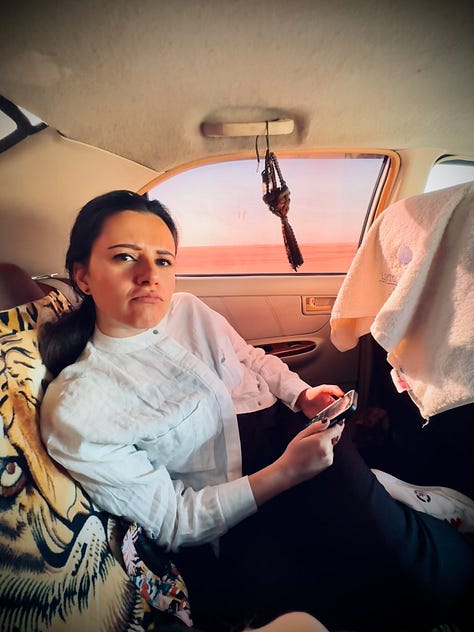


Da Aswan ad Abu Simbel sono tre ore di macchina in mezzo al deserto. L’asfalto perfetto stona con la sabbia che è a perdita d’occhio. L’orizzonte si confonde in fumi di polvere, ogni tanto appare il Nilo e intorno a lui campi di vita verde che sprizza.
La notte l’abbiamo passata sull’isola Elefantina che è un pezzo di terra in faccia ad Aswan, con case di fango, viuzze, immondizia, scalfitissimi resti di splendore faraonico, mandrie di bimbi e affacci grandiosi sul Nilo. Io che dai documentari di Piero Angela pensavo fosse grigio e bello fangoso mi stupisco a trovarlo azzurro splendente.
Sulla sponda opposta dune di sabbia e il labirintico monastero di San Simeone, costruito per convertire le popolazioni Nubiane ma abbandonato un millennio fa. La vecchiaia lui se la porta benissimo - perché non piove. Le sue mura beige di mattoni di terra rimangono salde ad affrontare il calore.
Io l’ho raggiunto a dorso di Zizo: dromedario pacioso ma un po’ troppo alto, per i miei gusti. Sull’isola elefantina siamo arrivati di sera, con una barca che ci separa: uomini e donne ai due lati opposti, sia mai che facciamo scalpore.


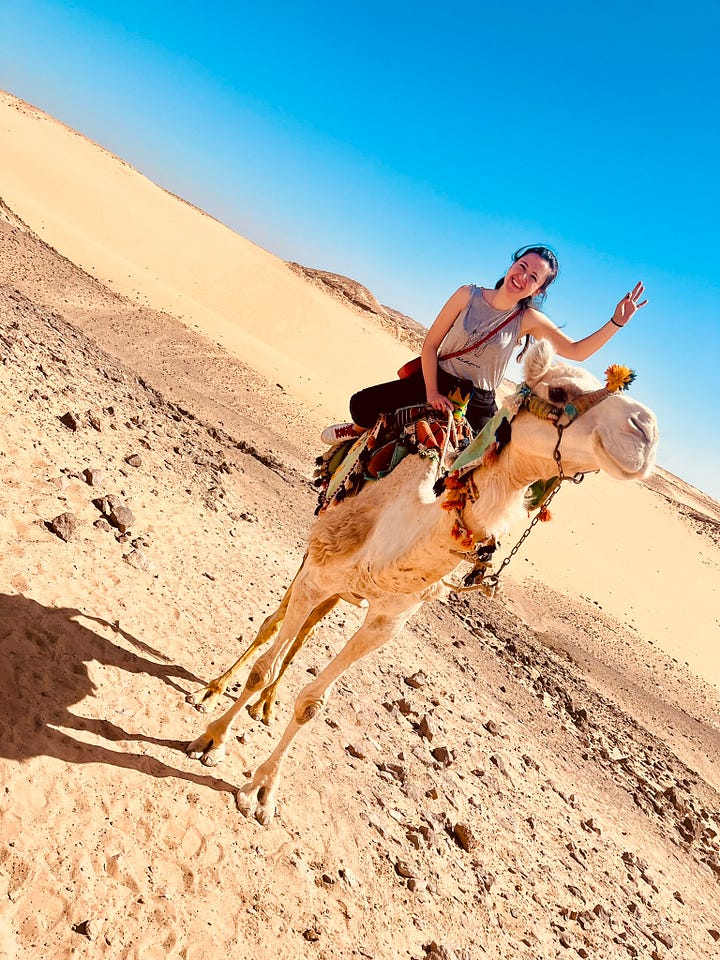

La notte è stata corta: Yasser ci aspettava presto sulla terraferma e infatti mi appisolo durante il viaggio. La musica che sceglie mi accompagna bene con melodie melense di sottofondo. Purtroppo non capisco le parole cantate - se non Habibi: amore mio.
Il sito Abu Simbel, una volta arrivati, pare finto. Troppo grande, troppo giallo, le sale troppo ben conservate - per essere vero. Ci sarebbe da passarci una vita ad osservare i dettagli. I templi sono due: quello più imponente è di Ramses II e accanto quello di Nefertari, la sposa più amata.
Di mogli ne ha avute oltre 40 e cento e più figli: a far crescere l’Egitto lui si è impegnato - su tutti i fronti. Ramses II era un soggettone e si piaceva proprio un bel po’. Ha cosparso il paese di sue statue monumentali, è raffigurato su ogni disegno, col suo nome ha coperto quello dei predecessori: l’egocentrismo di un graffitaro.
Ramses II ha stipulato il primo trattato di pace nella storia, alla fine di una guerra contro gli Ittiti. Combattimenti bloccati e accordo trovato. Però i negoziati non sono da eroi e a casa ha poi raccontato quel che voleva: nelle immagini è raffigurato a Qades in Sira che trionfa e sconfigge il nemico.
Gli antichi Egizi ne uscirono male, ma la gloria sui muri è quel che rimane.
Ad Abu Simbel ha dato il meglio: 20 metri di altezza per ogni statua e lì davanti ce ne sono ben quattro a creare una facciata colossale, scolpita nella roccia. Quattro Ramses giganti che guardano il Nilo e si mettono al pari delle divinità.
E uguale sarà nei templi di Luxor e di Karnak: ovunque ti giri le sue statue giganti, il suo nome e il suo pizzetto che svetta.
Lui che combatte, che caccia, che prega: Ramses II è un figo pazzesco. Propaganda e narcisismo a dir poco eccessivi, ma si è conquistato l’eternità.
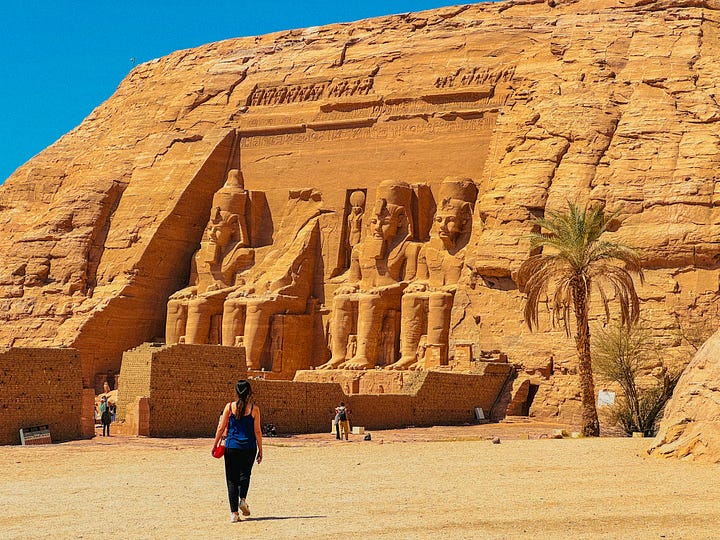


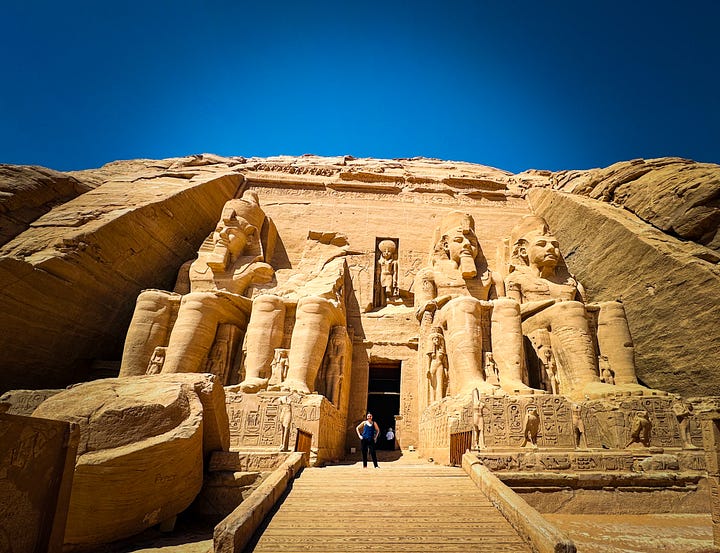
Sulla via del ritorno parliamo con Yasser o ci proviamo, vorrebbe gli creassimo una pagina web per pubblicizzarlo tra gli europei. Il discorso è complesso e Google translate fa del suo meglio, ma ci inceppiamo quando mi chiede di raccontargli quali fossero gli accordi presi con Yasser. Sono convinta che ci sia un problema di traduzione, uno scambio di parole dell’applicazione.
Però formula e riformula alla fine capisco, lo scambio c’è, ma è di persona: il nostro autista si chiama Sameh. Hamdi non poteva e ha chiamato Yasser, Yasser era occupato ed è venuto Sameh.
Sono interdetta, ma ormai è tardi, la giornata è finita e l’ho passata con lui. Ha guidato bene non ci si può lamentare, poi c’era Bob Marley appeso al tettino e Yasser scommetto non ce l’avrebbe avuto.
Sull’isola Elefantina ritorniamo che è tardi, al molo ci sono le bancarelle e ci fermiamo a comprare dell’acqua.
La bottiglia ce la vende un uomo rugoso, gli occhi coperti di cataratta, le mani tremano di Parkinson grave ed è contentissimo che siamo italiani. Perché lui in italiano sa quattro parole che sono “tutto bene” e poi “tanti auguri”.
Quando rispondiamo, con una risata spalanca la bocca: c’è un unico dente, l’incisivo rimasto, proprio nel mezzo.
Mi pare felice, ma che ne so io di che significhi vivere in questo posto nel mondo, per lui chissà che cos’è la felicità.
Però quando ride quegli occhi appannati brillano forte e a me pare di scrutarlo dentro bambino, nato e cresciuto sullo stesso terreno e poi invecchiato precocemente.
Precocemente per me, che invecchio lenta e rinchiusa in ufficio - credo che lui non mi invidi per niente.
Quando gli diciamo arrivederci, l’unico dente splendente riappare e anche la voce scandisce di gusto: tanti auguri italiani, qui tutto bene.
Gaia
Hai un amico a cui piace leggere? Regala un racconto di viaggio:
Ti è piaciuta la mia terza storia? Fammelo sapere! Lascia un LIKE, un commento oppure rispondi alla mail! Almeno so che non parlo da sola :)
Ho ancora due racconti egiziani per te, ma non vorrei che ti stufassi dell’Egitto. Quindi mercoledì prossimo facciamo una pausa e ti racconto una storia di città.
Seguimi su Instagram e su Facebook
TO RAMESES II, I GO WITH BOB MARLEY
Bob Marley's soft toy swings from the sunroof: following the curves of the road, he turns his thick dreadlock hair or the disproportionate joint in his mouth to me.
From the rearview mirror, meanwhile, hangs a blue smurf and a large wooden cross with a coral rosary attached underneath. A plucked white feather a foot long is stuck on the sun visor. Tied to the handle above my window is a woven macramé basket with a small bottle of thick liquid inside: I think it is made for perfume, a rudimentary Arbre Magique, but the only concrete visible effect is a brown resin dripping onto my white shirt.
Hello! I'm Gaia, thank you for being here to read my tales. Did you miss the previous? Click here: CHEOPE’S UBER
Subscribe in order to receive a story every Wednesday, support me, and make me happy!
The seat covers, both front and back, are made of spotted fleece with the big face of a pissed-off tiger. On the dashboard is a towel-holding giraffe that keeps falling off while driving.
The nice touch is a giant sticker: Mama - it towers to the right, stuck on the windshield. No, the best thing is the towel where the driver rests his head: there is a shell and it says Red Sea - the great Resort, resort that I guess now has one less towel.
I contacted the driver when I was in Italy, finding his number in an online forum. The comment said the name was Hamdi and he was very cheap, I wrote him on Whatsapp, we made arrangements.
Then yesterday he told: a friend will replace me, his name is Yasser. Okay fine, let's go for him, Yasser sounds like an honest name to me. He's waiting for us on board Nile with that freak car and first thing he offers us coffee.
Anyone who provides caffeine at six o'clock in the morning deserves my unconditional trust: we're ready to go.
From Aswan to Abu Simbel is a three-hour drive through the desert. The perfect asphalt clashes with the sand that is as far as the eye can see. The horizon blurs in fumes of dust, every now and then the Nile appears and around it fields of green life spurting out.
We spent the night on Elephantine Island, which is a piece of land in the face of Aswan, with mud houses, alleys, garbage, scaly remnants of pharaonic splendor, herds of children, and grandiose overlooks on the Nile. I, who from Piero Angela's documentaries thought it was gray and beautifully muddy, am amazed to find it glowing blue.
On the opposite bank sand dunes and the labyrinthine monastery of St. Simeon, built to convert Nubian peoples but abandoned a millennium ago. Old age he wears it well - because it doesn't rain. Its beige walls of earthen bricks remain steadfast to face the heat.
I reached it riding Zizo: a peaceful dromedary but a bit too tall - if you ask me. On the elephantine island we had arrived in the evening, with a boat separating us: men and women on opposite sides, heaven forbid we cause a stir.
The night was short: Yasser was expecting us soon on the mainland and in fact I doze off during the trip. The music he chooses accompanies me well with melancholic melodies in the background. Unfortunately, I do not understand the words sung - except for Habibi: my love.
The Abu Simbel site, once you arrive, looks fake. Too big, too yellow, the halls too well preserved - to be real. It would take a lifetime to observe the details. There are two temples: the more magnificent one is dedicated to Ramses II and next to it there is the one of Nefertari, the most beloved bride.
He had 40 wives and a hundred or more children: to make Egypt grow he was committed - on all fronts. Rameses II was a peculiar subject and he liked himself quite a bit. He sprinkled the country with his monumental statues, he is pictured on every drawing, with his name he covered the names of his predecessors: the egocentricity of a graffiti artist.
Rameses II made the first peace treaty in history, at the end of a war against the Hittites. Fighting stalled and agreement found. Negotiations are not for an hero, though, and back home he then told what he wanted: in pictures he is represented at Qades in Syra triumphing and defeating the enemy.
The ancient Egyptians came off badly, but the glory on the walls is what remains.
At Abu Simbel he gave it his best: 20 meters high for each statue, and there are four of them there, creating a colossal facade, carved out of rock. Four giant Rameses looking down on the Nile and putting themselves on a par with the gods.
And the same will be in the temples of Luxor and Karnak: everywhere you will see his giant statues, his name and his signature goatee.
He fights, he hunts, he prays: Ramses II is crazy cool. Propaganda and narcissism to say the least, but he has earned eternity.
On the way back we talk to Yasser or try to, he would like us to create a web page to advertise him among Europeans. The conversation is complex and Google translate does its best, but we jam when he asks what the arrangements with Yasser were. I am convinced that there is a translation problem, a misunderstanding of the application.
But he formulates and rephrases and eventually I understand, the exchange is there, but it is in the person: our driver's name is Sameh. Hamdi couldn’t make it and called Yasser, but Yasser was busy and Sameh came instead.
I am speechless, but it is too late now, the day is over and I spent it with him. He drove well you can't complain. Plus, there was Bob Marley hanging on the roof and Yasser I bet he wouldn't have it.
On Elephantine Island we return that it is late, there are stalls at the pier and we stop to buy water.
The bottles are sold by a wrinkled man, eyes covered with cataracts, hands shaking with severe Parkinson's, and he is delighted that we are Italian. Because he knows four words in Italian that are "tutto bene" (all good) and then "tanti auguri" (best wishes).
When we answer, with a laugh he opens his mouth wide: there is only one tooth, the incisor left, right in the middle.
He seems happy, but what do I know about living in this place in the world, for him who knows what happiness is.
But when he laughs, those clouded eyes shine brightly, and I seem to peer into him as a child, born and raised on the same ground and then aged prematurely.
Prematurely compared to me, aging slowly and locked up in the office - I think he doesn't envy me at all.
When we say goodbye to him, the one shining tooth reappears, and his voice joyfully chants: best wishes Italians, all good here.
Gaia
Do you have a friend who loves reading? Gift them a travel tale:
Did you enjoy my third story? Let me know! Leave a LIKE, a comment, or reply to the email! At least I know I'm not talking to myself :)
I still have two Egyptian stories for you, but I wouldn't want you to get tired of Egypt. So let's take a break and next Wednesday I'll tell you a tale story from the city.

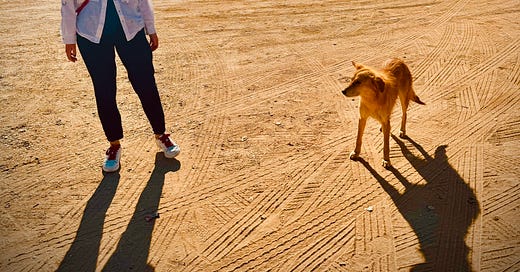



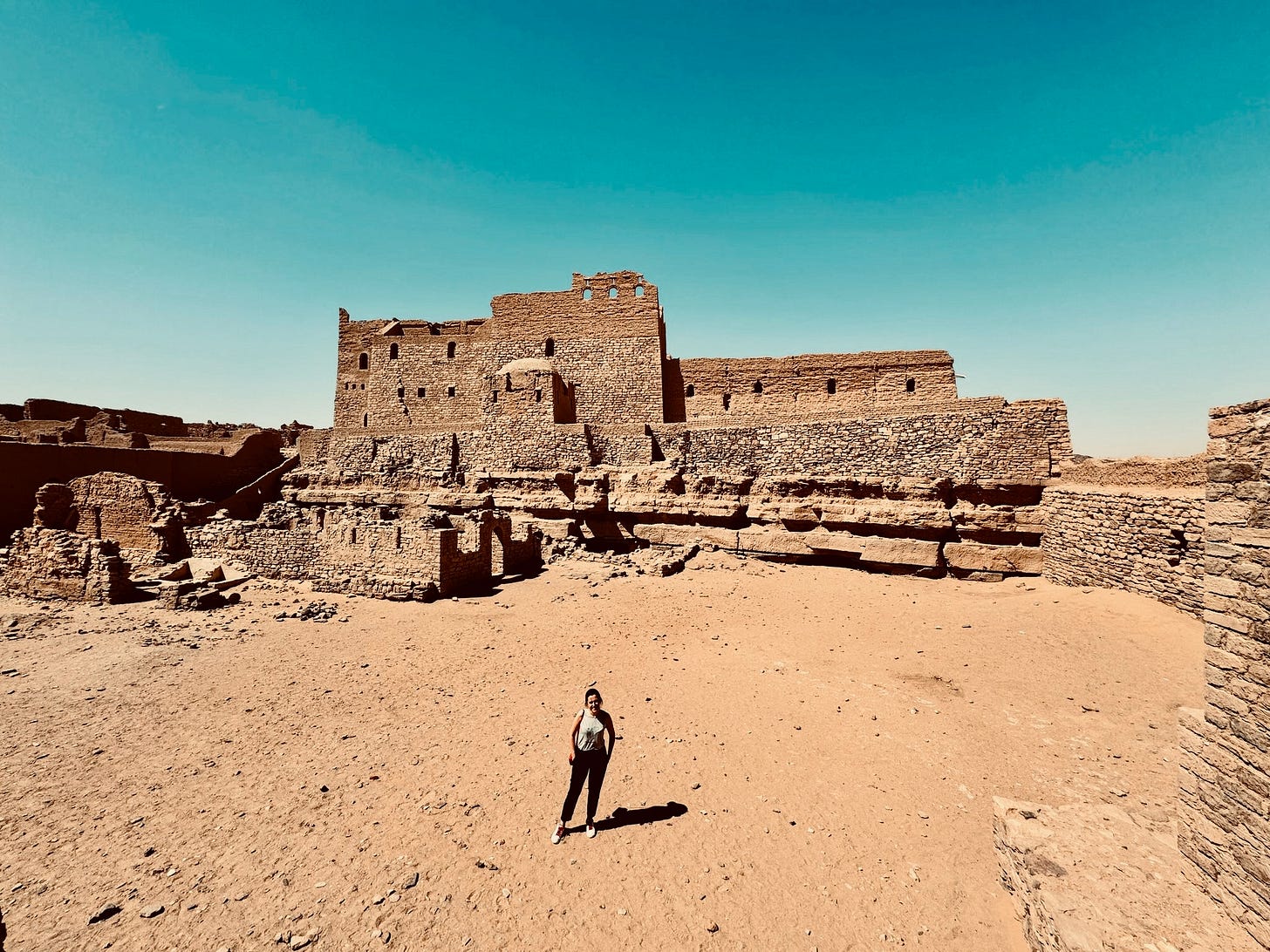
Bellissimo anche questo racconto Gaia!! 🥰👏👏
Veramente bello!